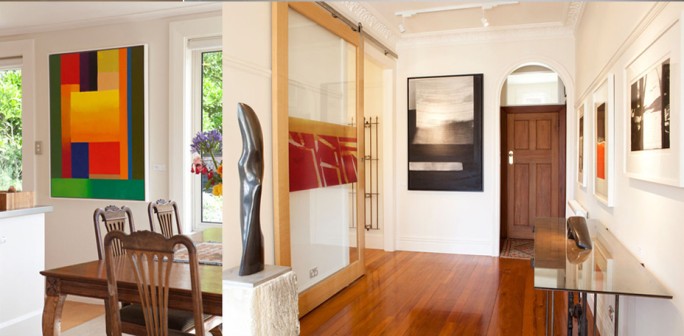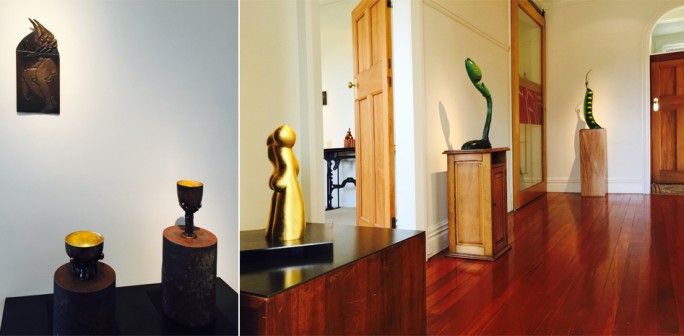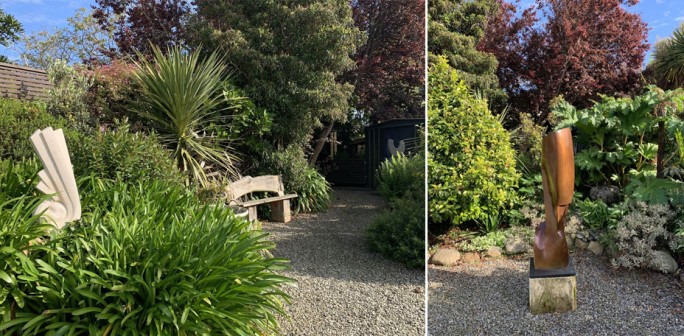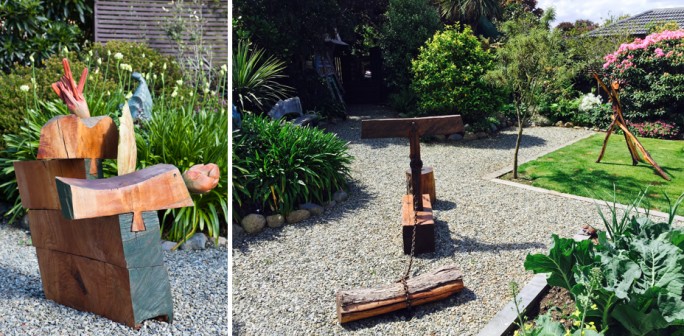Fe29 Gallery holds regular exhibitions of exciting works by a range of talented artists, national and international.
Works are displayed in a relaxed home environment, where clients can view in comfort and envisage how a selected work might look in its intended location.
Exhibitions of sculptures extend into the external spaces, which include a front courtyard and sunny private rear garden.

Celebrating our valued artists, three of whom (Philippa Blair, Greer Twiss and Chris Adams) passed during 2025, 9 Creatives & a Muse pairs the works of artists that lived and/or worked during the same era. With over 90 pieces, dating from 1949 through to the current day, works include sculpture, paintings, drawings, prints and mixed media, many of which are new to the gallery.
Some born in New Zealand, others finding their way here, but all represented in public and/or private collections throughout the world, artists in the exhibition include John Drawbridge MBE (1930-2005), Don Peebles, ONZM (1922-2010), Tanya Ashken, ONZM (1939- ), Robert Macdonald (1935- ), Peter Nicholls (1936-2021), Greer Twiss, ONZM (1937-2025), Chris Adams (1942-2025), Philippa Blair (1945-2025), Marté Szirmay (1946- ), Di ffrench (1946-1999), Christine Hellyar (1947- ) and more …
This exhibition encompasses the entire gallery and grounds and will be open throughout the holiday period. See homepage for holiday hours.
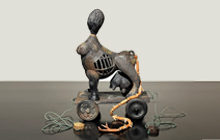
Born in Te Aroha in 1967, Bronwyn Gayle earned a Diploma of Craft Design from Christchurch Polytechnic in 1994. Moving to Dunedin in 1995, she studied at the Otago Polytechnic School of Art earning a Diploma in Ceramic Design (1995), a Post Graduate Diploma of Visual Arts (2019) and a Master of Fine Arts, with distinction (2022).
“As I age I am drawn to ruminate on the dairy farming environment in which I was raised, and contemplate present farming practices and their consequences. Our history of rural legend and search for identity needs reimagining in this time of environmental crisis. My mediums, methods, firing practices and design decisions all reflect these concerns.
Creating clay and glass toy-like sculptures is my way of facing difficult truths and imagining optimistic futures. My “never seeing dollies” and their “bovine cohorts” stand frozen within the conflict between contemporary dairy farming practices and our current environmental emergency.”
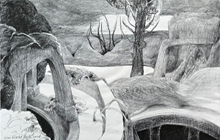
Christine Hellyar is one of Aotearoa New Zealand’s most accomplished contemporary sculptors. Born in Ngämotu New Plymouth in 1947, she graduated from Elam School of Fine Arts in 1969 and has exhibited continuously in Aotearoa and internationally since then. For more than 5 decades, Hellyar has innovated with sculptural processes, and worked across a wide range of materials including cast latex, bronze, textiles, large-scale installation, as well as drawing and photography.
Hanging Gardens & Aprons features C-type photographs of Hellyar’s 1985 apron sculptures (included in Set Dressing, Govett-Brewster, 2024) and charcoal drawings from her Hanging Gardens series (1989/1998). Recent crayon and dye botanical drawings, and a selection of sculptures in materials including bronze, hibiscus, wood fungi, feathers, rocks, silk,and paper, provide further examples of the diversity of Hellyar’s work.
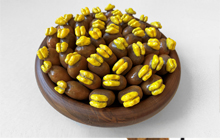
Throughout his lengthy and prolific career, Nicholls actively responded to, or paralleled, internationally significant movements in sculpture. His works granted importance to New Zealand nature as well as to the land that New Zealanders inhabit. He focused his practice on New Zealand landscape and identity centering on the dynamics of sited sculpture. Nicholls’ foundational material was wood – almost always found, fallen, discarded. His works were strong, typically abstract with the titles often revealing the references.
Works in this exhibition come from various series created over the years, including some of Nicholls’ favourite pieces – Consequential Landscapes and Breath from his Seedings series (2000-2008) and a swamp Kauri cross, embedded with brass (1998) and created at an important time in his life. Nicholls kept meticulous records and retained diaries, workbooks and associated resources. This exhibition includes a number of his maquettes, sketches and working drawings, as well as a selection of other ink and graphite drawings and pastel landscapes. Copies of Don Hunter’s book Dynamics | Memory | Grace, Peter Nicholls – Sculptor, (from which a number of the quotes above were taken) will also be available.
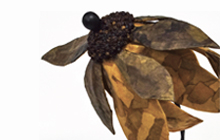
Viky Garden is an Auckland based multi-disciplined artist. Her work explores themes of impermanence, self-image, introspection and the female experience. During a year’s hiatus from painting (2024-25), Garden created two series of sculptures, each utilising materials appropriate to the subject. The Agony of Flowers, a metaphor for a moment caught in time, considers the experiences women grapple with when confronted with the inevitability of change. Utilising mesh, barbed wire, and dried peppercorns, these papier-mâché sculptures contrast the life affirming grace of flowers to accentuate what is unavoidable decay.
Crucibles is a stoic representation of the ongoing fight for women’s rights, issues which are under renewed threat today. Like entombed, mummified modern-day relics, these seemingly mute artefacts speak loudly to the historical straitjacketing of women by imposed notions of identity rather than as fully realised, Autonomous individuals. Vintage sewing patterns (used as the “skin”), are visually striking and rich in historical and cultural significance. Thematic implications related to gender politics, ageing, body dysmorphia, and the ongoing struggle for equal rights are alluded to by subtle, often cryptic references.
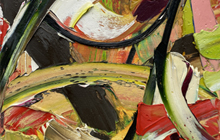
“In the past 50 years, Philippa Blair has been described as a traveller and a restless spirit, fluent in translating the tumultuous world around her into vibrant observations that are boldly autobiographical but also hum with the familiar rhythms of life.” Chloe Geoghegan, curator, Te Uru Contemporary Gallery, Waitakere.
Blair was born in Christchurch in 1945. She died in Auckland, in January 2025.
Celebrating her colourful life and personality, Vibrant Observations presents a selection of oils on canvas, small gouache works, and vellum & ink drawings, produced during the late 1990’s and early 2000s, in the Angelus Place studio, (Venice, CA) that Blair and husband, architect and painter, John Porter (1941-2018) made and shared. Created at what was a particularly happy and productive time in her life, these energetic and colourful works capture the rhythm and excitement of her new fast-paced life in the USA.
Also on show are a small number of Blair’s large, historic works (books and cloaks) on unstretched canvas, created prior to her move to California.

Born in Vilnius, Lithuania in 1983, Gerda Satunas grew up in a family of artists. She completed secondary education at M.K. Ciurlionio National Art School, before embarking on further design studies in Lithuania, Paris and Amsterdam. In 2011, she relocated to study at the London College of Fashion (University of Arts, London). While there, she became involved in artistic projects for Madame Tussauds Museum and the Royal Opera House, London. Gaining a BA (Hons) in Costume Design for Performance (2014), Satunas moved to Auckland, continuing her artistic journey in fashion. Moving to Dunedin in 2021, she discovered the beauty and texture of ceramics.
Journey into the Unknown is an exploration of ceramic forms reflecting Satunas’ journey from a life in Lithuania to an unimagined life in NZ. In an intimate journey of contrasts, mood and colour, she strives to find peace, the love of self and a path to achieving her dreams for the future.
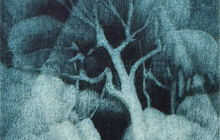
Born in England in 1942, Chris Adams studied geology as a student at the University of London and Oxford University, and then as a researcher in Canada. Coming to NZ in 1969, he continued work as a geochronologist, mostly on Gondwana studies. In the 1980’s he continued these studies collaboratively in Germany as a Humbolt Fellow.
With a long interest in painting and drawing, Adams was introduced to printmaking in 1987. It was meeting John Drawbridge in 1994 that led to his fascination with the mezzotint process. Covering 3 decades (1994-2024), Adams’ prints have been inspired by significant areas of interest in his life: the ways in which contemporary NZ poets have made their mark here; his research travels throughout Zealandia; and a long-time love of the Otago Peninsula.

A brilliant and diverse visual artist, Drawbridge created a challenging, exciting and varied body of work in a career spanning over 50 years. Oil and watercolour painter, printmaker, muralist and stained glass artist, he was also a natural teacher. One of New Zealand’s leading and most accomplished artists, Drawbridge was awarded an MBE (1978) and an Honorary Doctorate of Literature, Massey University (2002). His work is held in some of the world’s most celebrated collections, including the British Museum and Victoria and Albert Museum, London.
From the Estate includes a selection of Drawbridge works from 1949 through 2005. These include a watercolour and rare, signed etchings and mezzotints, only recently released by the estate. Also included are paintings (oil & watercolour), and ink and graphite drawings.
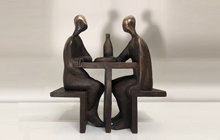
Fe29’s holiday exhibition, Conversations is a group show featuring many new works. While it will run until January 25, it is an evolving show so those who purchase can remove works in time for Christmas gift-giving. Introducing the exhibition, mezzotints by John Drawbridge sit alongside a series of Marian Fountain small bronzes of couples deep in conversation. Moving through the gallery, we are encouraged to imagine some of the topics under discussion.
In the main areas, the conversation centres around climate change. Pacific drawings in mixed media by Christine Hellyar are accompanied by water vessels in anodised aluminium and nickel silver by local metalsmith Johanna Zellmer, and small bronzes by Jim Wheeler, Marté Szirmay, and Samantha Lissette. In other spaces, love, travel and aging are some of the topics of conversation in paintings, prints and sculpture by artists including Philippa Blair, Evan Woodruffe, Viky Garden, Bill Hayes…
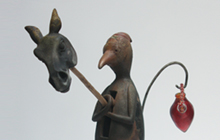
Born in Te Aroha in 1967, Bronwyn Gayle earned a Diploma of Craft Design from Christchurch Polytechnic (1994). Moving to Dunedin in 1995, she studied at the Otago Polytechnic School of Art earning a Diploma in Ceramic Design (1995), a Post Graduate Diploma of Visual Arts (2019) and a Master of Fine Arts, with distinction (2022).
“While searching through old photos I came across two images of myself as an infant with a rocking horse. In one I wore a red hooded dress and red shoes. The characters “Little Red” and her “Equine Companion” are the origin and inspiration for the works in the ‘Toys and Tales’ exhibition.” The saggar-fired ceramic objects also have precedence in the ancient clay toys excavated throughout the world. They display uncontrolled marks left by the smoke and flame. Combined with reimagined found objects and cast glass, the works present a perilous juxtaposition and an enticing invitation to play with danger.
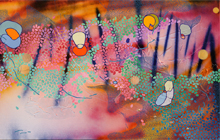
Conceived over several weeks in New York’s East Village at the start of the year, this new suite of paintings by Evan Woodruffe shimmers with light. Agile brush marks dance over 2D and 3D surfaces. Their layers are porous – they are sprayed, drawn, painted, and collaged in a concert of saturated, pastel, translucent, and opaque hues.
These are paintings of food, music, laughter, cocktails, and travel. They are social, they are movement, they entice and delight. Smoked & Roasted is a cocktail served at the bar across the street from where Evan was staying, and its balance of spice, sweet, citrus and salt has been brought back as a suite of luscious coloured paintings.
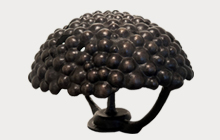
Introducing this exhibition are four new Marté Szirmay bronze sculptures, inspired by the poem ‘After The Storm’ by Wellington writer, Alistair Te Ariki Campbell. Building on the theme are many previously unshown early bronzes by Auckland-based, American-born sculptor, Bill Hayes.
Complementing the bronzes of Szirmay and Hayes, are recently released works on paper by selected Fe29 artists. These include rare, signed etchings and mezzotints by the late of John Drawbridge (MBE), early etchings by Robert Macdonald (currently of Wales), and monotypes from Kristin O’Sullivan Peren’s ‘Breath’ series.
Also showing in non-exhibition spaces of the gallery, are further rare and unique, signed prints (etchings & aquatints, and mezzotints) recently released by the Drawbridge estate. Other unframed prints are also available to view on request.
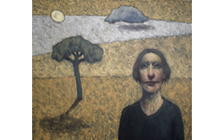
Viky Garden has a consistent and focused body of work dating back 35 years. Almost exclusively using herself as the subject, she explores themes of impermanence, self-image, introspection and the female experience. ‘New Studio Work’ includes new paintings, sculptures and prints from 2023/24.
‘The Sisterhood Sculptures’ (2024) is a group of four sculptures borne of Garden’s 1996 Sisters of Mercy paintings. A suite of 40 individual hand-rubbed intaglio prints, ‘The Dementia Pear’ (2023) documents Garden’s mum’s struggle with dementia. ‘The Memory Chair’ painted after Garden completed ‘The Dementia Pear’ prints, is a contemplative painting of this uncharted journey, while The ‘rabbit’ paintings and ‘The Broccoli Tree’ (sparse airless landscapes and skies) are her response to a world in crisis.
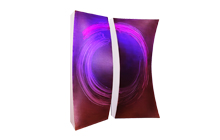
Acknowledging light as our oldest time tool, Hall first explored the use of light and time within her work in 2015. She refers to these works as ‘light infused paintings’. Highlighting time as a precious commodity, Hall uses an act of spontaneity to represent our actions in the now. Archived in paint, this spontaneous mark is extended into our future, to become past. Our actions today impact beyond our now.
Hall combines traditional techniques of painting in oil on hand-stretched forms, with the science and colour of infused physical light. Her works exist as paintings by day, transforming into something ethereal as daylight fades, the colour and energy of emanating light from within intensifies.
In Time, is a progression in Hall’s work. Her new light-infused paintings are brighter, lighter and looser in style. Also offering opportunities for viewer engagement are Hall’s 2021 deconstructed paintings in acrylic and her 1.7M tall light sculpture Flirt (long-listed in the Aesthetica Art Prize, England 2015).
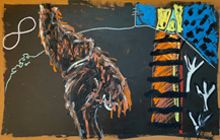
John Lyall, was born in Sydney, Australia in 1951 and has a Bachelor of Fine Arts from the Sydney College of the Arts. Moving to New Zealand in 1983, he gained a Masters in Fine Arts (First Class Honours Sculpture) from the University of Auckland (1993/4), receiving the Fowlds Memorial Prize awarded to the pre-eminent Fine Arts Student (Elam). The feature image, Copper Moa, an oil stick on heavy paper by John Lyall, is one of several works included from his 2002 series, A Moa, A Math, A Mount – the oil stick drawings.
Born in New Plymouth in 1947, Christine Hellyar completed a Diploma in Fine Arts (Hons) at Elam in 1970, spending the next 15 years teaching art at the school. Exhibiting consistently both nationally and internationally, her practice involves wall art, sculpture and installation. In our Autumn Collection, we include mainly mixed media works of Hellyar’s from 2015 – 2022.
Also on show are a number of oil paintings from Kristin O’Sullivan Peren’s Mata-au series.
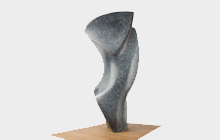
Tanya Ashken, a New Zealand silversmith and sculptor, was the second artist to be awarded the Frances Hodgkins Fellowship (1967). Born in London (1939) Tanya became the youngest person to acquire a silversmithing hallmark at just thirteen. She was awarded a diploma in silversmithing from the Central School of Arts & Crafts, London in 1960,and went on to study sculpture at the Atelier de Del Debbio, Paris, and Camberwell Art School, London.
Tanya married NZ artist John Drawbridge (1930–2005) in 1960, and emigrated to NZ in 1963. She was awarded many jewellery and silversmithing commissions, and went on to earn a number of major sculpture commissions including Seabird V (1974) for the NZ High Commission, Canberra; the 3-piece water sculpture Albatross (1986) for Frank Kitts Park, Wellington and the Treaty of Waitangi Sculpture (1996) for the Court of Appeal, Wellington. She has exhibited widely throughout NZ and has works in many private collections.
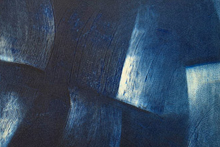
Drawbridge was a brilliant and diverse visual artist. In a career spanning over 50 years, he created a challenging, exciting and varied body of work. His Wellington studio overlooked the Pacific Ocean and he often explored the nuances of the coastline and ocean in his paintings and prints. Interested in what he called the “atmospheric elements of the earth and in humanity”, he experimented with how combining intense colour and delicate mark-making could create rich experiences for the eye and mind. Unusually for him, this work responded to a political issue – the testing of nuclear weapons in the Pacific.
The Protest Works includes a series of etchings created by Drawbridge in 1966 and closely related to his raked oil paintings of the early 1960s. Here Drawbridge creates a series of raked lines that flow around, under and over each other, a satisfying visual equivalent of the movement of the wind through the air, and a perfect matching of process, media and subject.

“Most of our experience of the world is invisible – our thoughts, dreams, emotions; the way we move Through life; and our relationships with others.” In his abstract paintings, which range from the tiny to the gargantuan, Woodruffe attempts to tease out this internal world, using colour to affect our emotions.
While painting remains the core of Woodruffe’s practice, his works have provided the imagery for printing onto fabrics, furniture, architecture, and automobiles (BMW, Sydney and Jaguar, Singapore). Through collaboration with designers and performers, he has extended his painting practice off the wall and into our 3D world.
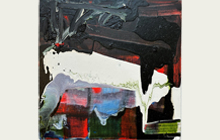
Geographical consciousness plays an important role in Philippa Blair’s painting. Urban structure, people, language, music, weather and other locational elements all contribute to an atmosphere that she captures in her vibrant works. ‘Out of Place’ includes oil paintings from 1995–2013, when Blair was based in the USA. Moving to LA, Ca, her early works reflect aspects of a city strikingly different from the places in NZ where she grew up – high density living, spaghetti-like highways, and the frenetic pace of city life.
References to the strong winds and native American presence can be seen in ‘Chinook’, painted after a road trip through Montana, while a small number of works reflect on memories of special places from her early life in NZ. Quite different influences can be seen in the five 2007 works created from her experiences during a trip to Taipei when she was one of five NZ artists selected for the Art of New Zealand, 2006 exhibition
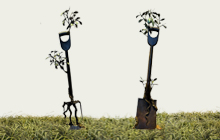
Regeneration is a winter collection featuring works by existing Fe29 artists and three artists new to the gallery (Jim Wheeler, Bill Hayes and Katie Blundell). Newly received bronze sculptures and medals by Marté Szirmay are accompanied by a number of rare John Drawbridge prints recently released by the family.
The feature work, Regeneration Oak Fork (2013), is one of a small selection of unique, bronze sculptures by Auckland-based sculptor Jim Wheeler. Rounding out the show are a small number of ceramic pieces by Bill Hayes and mixed media works by Katie Blundell.
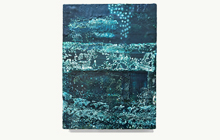
“In 2021, my grandmother, Audrey Betterton passed away after celebrating her 99th birthday with our family. Prevented from attending her burial due to COVID restrictions, I was inspired to create a body of work in her honour.
She Marked Her Name with ‘X’ explores themes of memory, identity and heritage through the lens of the women in my family. Incorporating items such as letters, drawings, photographs, lace, tea leaves, sand and rust, these multi-layered encaustic works are rich in texture and meaning. Each layer tells a story, whether it be the delicate lace etched or embedded in the wax that speaks to the fragility of memory, or the rusted metal that represents the passage of time and the decay of physical objects.
In using these fragments of history I aim to highlight the often overlooked contributions of women throughout history and the ways in which their experiences continue to shape our present.
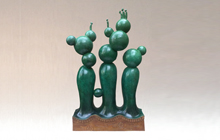
With over 40 years of creating sculptures in bronze, Fountain’s work has been exhibited at the British Museum, National Gallery of Scotland, the Museo Archeologico of Milan, Auckland Museum, and the French Mint. She has designed and made medals for the Commonwealth Games (1990), America’s Cup (2003) and Entente Cordiale (2004). In 2009, her series of 34 bas-reliefs, was installed in the Royal Infirmary of Edinburgh Hospital. Her bronze monument, The Earth Remembers, was commissioned in 2017 to mark the first World War Centenary commemorations at Carriere Wellington Museum, Arras, France.
Named after the title piece, Parallel Realities is an exhibition featuring works created in 2019-20. In these, Fountain uses biological metaphors to illustrate what it is to be alive. By utilising complementary forms on opposite sides of
the works, she encourages a deeper conversation. Accompanying these works are recently received medals, bas-reliefs, and sculptures (1988-2023).
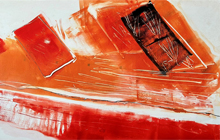
Kristin O’Sullivan Peren is a multi-media artist whose practice responds to the extremities of land, language and object. Her work comes from a history as a print-maker, visible by a clear and developed methodology derived from materials and process. Recent large-scale projects extend within photographic, sculptural and electronic fields using both digital and analogue technologies. O’Sullivan Peren exhibits locally and internationally in public spaces, contemporary project galleries and at worldwide artist residency communities.
Irreplaceable is an exhibition primarily of O’Sullivan Peren’s prints from 1991-2011. In these she explores the rapid acceleration of climate change and its impacts both by and on humans. Early works from her iconic series The Irish (1996), highlight specific impacts, while selected monotypes from a later series, Emergence (2011) expands on her message – “the environment is not simply a source to nourish and sustain cultures and communities, but an irreplaceable body of land, light and water.”
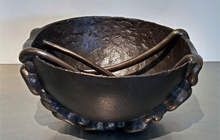
To welcome-in 2023, our new Summer Collection includes selected new works from four current Fe29 artists. The feature work, Loose Ties from Marté Szirmay’s 2019 Loops and Knots series, is a precursor to Contained and Protected, the work awarded curator’s choice for the McConnell Family Supreme Award for Sculpture in the Gardens (Auckland) 2019/20. Accompanying Szirmay’s bronzes are ten fun watercolours created by Philippa Blair in Venice, California in 2002.
In the hallway are four encaustic works by Amy Melchior, including two pieces completed just this month. An older work, Lapis – Metamorphic Rock, is a special painting created using pure lapis lazuli pigments made in Italy especially for her. A solo show of new Melchior work is scheduled for later this year. A selection of bronzes by Samantha Lissette (including her new miniature Botanicals, Vegetables and Insects) round out the show.
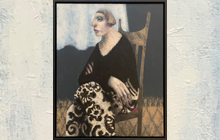
Throughout the ages, artists have been inspired by the human body. Many view art as a window into real life, however, we rarely comprehend people simply by considering their anatomical components, but rather, by focusing on different features, emotions, ideas, and memories. Portrayal of the Human Form focuses on a selection of works by Viky Garden and Edward Povey. Garden’s works reveal a self-reflective study of the political sphere of womanhood, in which she uses her own body as a form of language. In her latest series, Ancestral Roses, she addresses the nature of impermanence.
Edward Povey (Wales) has continued to experiment throughout his long career in painting. The works included in this exhibition demonstrate his ongoing efforts to better portray complicated and vulnerable emotions.
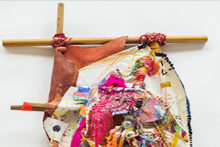
Born in Bristol in 1977, Wellington-based artist, Siân Quennell Torrington graduated BA in Philosophy, Otago University (1998) Diploma Fashion and Textiles, NMIT (2001), and MFA with Distinction, Fine Arts, Massey University (2010). With numerous solo and group shows to her credit, her work has been commissioned for public art institutions including Soft is Stronger than Hard (City Gallery Wellington), The Way You Have Held Things (Christchurch Art Gallery), and the Public Art Fund, Wellington.
Staying open is a practice is an exhibition of pieces and fragments lovingly bound, stitched and layered together to make new wholes. In a constantly changing world, what has remained stable for Torrington is practice – working through expressive movement and opening up the body to keep discovering new feelings and spaces – “not getting stuck on what we thought we knew”.
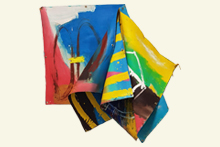
Long interested in breaking down the traditional barriers of art making, and in the literal and symbolic idea of metamorphosis, Blair spent many years exploring the possibilities of unstretched, folded and hanging canvas, unrestrained by the limitations of the frame. Blair’s trademark works of the 1970s-90s were canvas cloaks, teepees, and books. Blurring the line between 2D and 3D, these theatrical works reference her love of sculpture. Bamboo sticks extend the works beyond the wall, bringing them to life as if in a dance.
Metamorphosis includes a number of Blair’s cloak paintings created during the early 1980s and exhibited in a solo exhibition at the Shippee Gallery, New York in 1984, as part of NEW ZEALAND ART IN AMERICA. Curated by Mary Evangelista, this event involved 17 NZ artists (including Len Lye, Billy Apple, and Ralph Hotere) showing in 14 art galleries throughout New York City. Hanging alongside her cloaks are a number of Blair’s ‘books’ from the 1990s. In these, pages can be viewed alone as individual works or chapters, or together as events that fold over and into one another, revealing traces of the past alongside glimpses into the future.
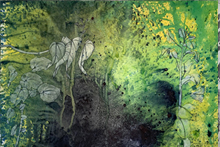
CHRISTINE HELLYAR was born in New Plymouth (1947). She completed a DFA (Hons) in 1970 at Elam, where she subsequently taught part-time. Since leaving in 1996 to work full-time in her studio, she has accumulated numerous awards. Exhibiting consistently in NZ and internationally, Hellyar’s work has been included in many major exhibitions, and her work is held in most NZ public collections. The first series of drawings in this exhibition is titled ‘Finding Ferns in the Forest’. These are accompanied by two new bronze works (ferns) by Hellyar. The second series of drawings relates to the Rangiora plant.
While the majority of works in this exhibition are by Hellyar, we have chosen this exhibition to introduce a new artist to Fe29. Samantha Lissette’s bronzes sit comfortably alongside Hellyar’s Rangiora drawings. SAMANTHA LISSETTE exhibits regularly throughout NZ and internationally, and her work is in public and private collections across NZ and overseas. She has a degree in philosophy from Auckland University and in her art practice she explores the relationship between ‘designed’ elements in the natural world and man’s adaptation of them. There is a strong narrative quality to her sculpture, questioning aspects of the human condition. Often employing humour, she brings a sense of playfulness and delicacy to a medium traditionally associated with weight and substance.
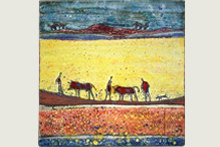
With a career in the arts spanning over 60 years, de Lange has been a potter, fashion designer, author, and photographer. She is however, best known for her unique ceramic paintings created using many layers of glazes fired over 3 days. Through endless experimentation, de Lange has discovered how to handle the glazes to their greatest advantage. The glaze effects are rich, luminous and complex like stained glass, sometimes with a jewel-like quality.
After a 5 year hiatus, de Lange is once again creating. Her new works are on a smaller scale (a more suitable size for someone nudging 80). They also reflect a more relaxed and contended Gennie.
We are delighted to present this survey show comprising 40 works representing each of the six decades of her career – from the early 1970s through to the present day.
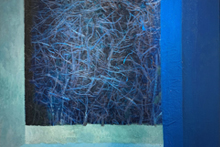
This Autumn collection includes works by a selection of Fe29 Artists, including John Drawbridge, Tanya Ashken, Viky Garden, Greer Twiss, Marte Szirmay and Marian Fountain. The exhibition includes newly released works from the estate of John Drawbridge, including paintings, etchings and mezzotints. Drawbridge was a brilliant and diverse visual artist. In a career spanning over 50 years, he created a challenging, exciting and varied body of work.
The exhibition also includes a selection of new paintings by Viky Garden.

Robert Macdonald was born in the UK in 1935 and emigrated to New Zealand with his family in 1945, settling in Ruawai (Kaipara Harbour). Training as a reporter, he worked as a journalist at the New Zealand Herald. In 1958, he made his way to London by boat, where he was accepted at the Central School of Art. While Chief Diplomatic Correspondent, he travelled widely with Britain’s Foreign Secretaries, but continued to paint in his spare time. In 1972, six of his large Maori portraits were exhibited in New Zealand House in London. In 1976 he undertook postgraduate studies at the Royal College of Art, London and later returned to the Central to take an advanced printing course.
Macdonald has since become a well-known artist in Wales and has been chair of the Welsh Group (the senior association of professional artists). He is currently a director of the Swansea Printmaking Workshop and President of the Royal Watercolour Society of Wales. His prints have been widely exhibited internationally and are held in many public collections including the Victoria & Albert Museum, London. The River Crossing includes a selection of drawings in charcoal from 1990-2005, and ink on paper from the 1960’s and 70’s. He hopes you enjoy the show.
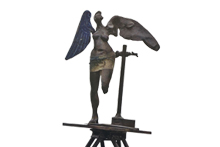
Often called the godfather of contemporary sculpture in New Zealand, Greer Twiss has been making and teaching sculpture for more than 60 years. Born in Auckland in 1937, he graduated with honours from Elam School of Fine Arts in 1959. Taking up his first teaching position at Elam School of Fine Arts in 1966, Twiss had a long career teaching at the Auckland University. He was appointed an Associate Professor, becoming Head of Sculpture in 1974. Besides teaching, Twiss has maintained a prominent sculpture practice, exhibiting extensively throughout NZ and overseas. He has been the subject of two retrospective exhibitions (City Gallery Wellington and Auckland Art Gallery), and his sculptures are included in all major public and many private collections in NZ, as well as in numerous international collections.
In 2002 Twiss was awarded an ONZM for sculpture, and in 2011, he became the recipient of an Icon Award from the Arts Foundation of NZ, an award limited to 20 living art-makers. This exhibition of sculpture and drawings by Twiss offers a rare opportunity to see a survey of work produced over some 50 years, by one of NZ’s leading sculptors. The works show changes in style, technique, subject matter and treatment of materials as Twiss explores interesting ideas and developments.
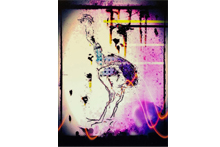
Born in Sydney in 1951, Auckland based, multi-media artist John Lyall graduated with a BA (Visual Arts) from Sydney College in 1982, and an MFA (Sculpture) from Elam in 1993. His multi-disciplinary background has ensured that he continues to work in many media. He has presented exhibitions and performances in Japan, South Korea, UK, Australia and NZ.
Still Iconic… a show presents a selection of Lyall’s oil stick moa drawings (2002) and Meccano moas (2013) alongside a series of new, seriously manipulated drawings and photographs. Starting with iPad drawings and photographs of earlier works, Lyall has digitally manipulated each image using a unique series of applications and programs (30+) – sometimes hundreds of times. All tweaked, adjusted, altered and ‘improved‘ by his fingers interacting with the image on the tablet. Using the iPad Pro, with bigger screen, better colour and higher resolution, these much-altered images are even better, denser, stranger and wilder than his earlier digital works.
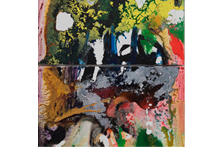
Born in Christchurch (1945), Blair graduated with a Diploma in Fine Arts from Canterbury University in 1967. With more than 100 solo & 300 group exhibitions, she has taught and exhibited internationally for over 40 years. Represented in numerous public and private collections worldwide, Blair has works in The British Museum, Chan Lui Museum, Taiwan, Long Beach Museum of Art (LA), The National Art Gallery (Canberra), Te Papa, Auckland & Christchurch Art Galleries, as well as the corporate collections of Citibank, Citicorp, General Electric and Hong Kong & Shanghai Banks.
Channelling energy from various sources (cultural, political, geological), there is no doubt that Blair’s works have drama. They also have wit and the element of the unexpected. After more than 30 years since Philippa’s work has been seen in Dunedin, ‘Fera Natura’ is an exhibition of selected works from 2005 – 2021. It includes works from Blair’s time living in vibrant overseas cities and since she returned to her quieter New Zealand home. Drawings and collages are shown alongside mixed-media paintings, illustrating Blair’s process of working ‘from drawing to painting’.
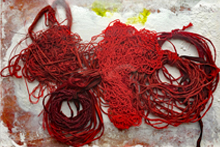
“Fields of Colour is my response to some writers’ claims that ‘only painters understand colour’. (What about sculptors, printmakers, Florists, weavers, and dress designers?) The works draw on my research into weaving materials and dyes, a task in which I was aided by talented Māori and Hawaiian friends. Using commercial dyes on a variety of materials, I recreated the colours of plants named in the titles of the works. I wanted to use these titles as, for me, the names of the colours and plants evoke landscapes.
The sculptures are reminiscent of museum displays in the use of wooden trays and heavy protective glass. The backgrounds in each work are museum-like too, in that they are reminiscent of historical walls and furniture, a look achieved through the use of clay and plaster. I have used both the weaving materials and the display box technique before, but never together until now. There are plant references in these works that I have included often in my drawings – using them in this way is a first as well.”
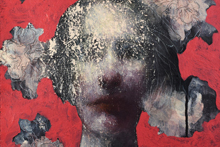
From her earliest surviving work, Self Portrait at 16 (1977), Viky Garden has consistently challenged the assumption that portraiture is no longer relevant in contemporary art. Garden’s work, whether it be painting, pinhole photography or sculpture, has from the very beginning, engaged in a self-reflective study of the political sphere of womanhood, in which she uses her own body as a form of language.
GRIT is a poignant reminder of impermanence and change, reflecting and rearticulating the personal and universal aspects of female mutability that has characterised Garden’s output over three decades. Painted during the Covid pandemic, these visceral, deliberately unrefined images speak to the present through a restrained yet direct and unflinching gaze, subtly considering notions of identity, isolation & vulnerability within a perspective that is emotionally & intellectually edifying and wholly feminine.
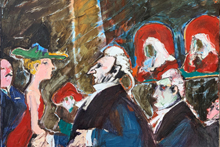
With over 60 ‘never seen before’ ink drawings, prints, mixed media works and oil paintings from the late 50’s to the early 70’s, THE EARLY YEARS presents snippets from Macdonald’s adventurous early life as an artist and journalist. Born in 1935 in Lincolnshire, Macdonald emigrated to New Zealand with his family in 1945. With art studies out of reach, he trained as a reporter, working for the NZ Herald until 1958, when he signed on as unpaid crew on a sailing ship bound for Sydney. Making his way to London, he enrolled at the Central School of Art where one of his first etchings was included in an international exhibition of Twenty-five British Printmakers, among them Henry Moore, Barbara Hepworth and Graham Sutherland.
Working as a journalist in Fleet Street throughout much of the ‘60s, he painted in his spare time. His works were often satirical – the journalist observing the world around him with cynical eyes. During his time as chief diplomatic correspondent for the Central Office of Information, he flew with foreign office ministers to Idi Amin’s notorious regime in Uganda to rescue a British lecturer in danger of execution. He visited China, Arabia and the UN in New York before, in 1976, enrolling as a mature student at the Royal College of Art. Now a successful artist living in Wales, he is president of the Royal Watercolour Society of Wales, and a director of the Swansea Printmaking Workshop. His prints have been widely exhibited internationally, including in the European Parliament in Brussels, and are held in the Victoria and Albert Museum, London and other public collections.

Born and raised in Whanganui, Hamish Horsley was based in London for over 30 years, working as a professional artist and teacher. He built an impressive reputation with many significant and often monumental public art commissions and private projects. Foremost of these are The Way in Durham, UK and the widely acclaimed Tibetan Peace Garden situated outside the Imperial War Museum, London.His works are found throughout the UK, Northern Europe, the Middle East and more recently India, Vietnam and Thailand.
Maquettes provides us with a timeline of the artist’s exploration of themes and imagery over the past 20 years. With a continuing focus on environmental harmony and the nature of form and design. Horsley continually adapts the patterns and rhythms occurring naturally in the elements and earth formations. Beginning with small sketches and a lump of clay, Horsley works his way into his projects, finding the immediacy and flexibility in the clay an ideal way to develop sculptural images. These are further progressed in his monumental stone carvings. The clay ‘sketches’ remain both as reference points in his working process and as sculptures in their own right. These intimate works, cast in bronze for this exhibition, mark time and place.
This exhibition also includes a number of Horsley’s sketches, drawings and gouache paintings.
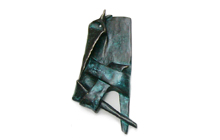
This exhibition of medals and sculptures welcomes Marté Szirmay to Fe29.
Born in Budapest in 1946, Szirmay arrived in New Zealand in 1957 following the Hungarian revolution. With a DFA (Hons) from the Elam School of Fine Arts and a Teaching Diploma, she has dedicated over 40 years to teaching art to new generations while continuing to exhibit her work nationally and internationally.
Szirmay is a long-time advocate for the protection and health of our planet Earth and promotes unconditional love and respect for all her sentient beings. “While we are debating the rapid disintegration of our planet, not all accept that we as a human race are in any way responsible for the plunder, exploitation and pollution of her.”(Marté Szirmay)
Accompanying Szirmay’s bronzes in this exhibition, are works by other distinguished Fe29 artists with a similar respect and concern for our environment – Tanya Ashken, Hamish Horsley and Marian Fountain.

Gennie de Lange is best known for her ceramic paintings created using a unique glazing technique developed over some 40 years. Working on unglazed terracotta, she paints many layers of glazes. The tones and colours (matt pastels before firing) are completely transformed after three days in the kiln. Some glazes are transparent, while others opaque. All are difficult to apply evenly and some react unfavourably when applied near others. Through endless experimentation, de Lange has discovered how to handle these to their greatest advantage.
Looking Back is de Lange’s first exhibition in 4 years and may well be her last. Stopping work in ceramics 5 years ago, after suitable earthenware tiles and glazes became almost unobtainable, the works on show are from her private collection.
There is a very painterly feel to the works and the glaze effects are rich, luminous and complex, with a jewel-like quality.
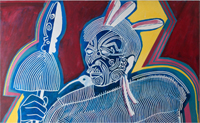
DON PEEBLES ONZM (1922-2010)
JOHN DRAWBRIDGE MBE (1930-2005)
ROBERT MACDONALD (WALES)
In 1962, three friends were photographed fooling around with paintings and frames in the stairwell of 5 Nugent Terrace, London, a home they shared in common. More than 55 years later, “Three Friends, Three Paths” brings these friends, renowned artists Don Peebles (ONZM), Robert Macdonald and John Drawbridge (MBE) back together through an exhibition of over 50 of their paintings on canvas, works on paper (watercolours, drawings, original prints) and mixed media works.
The show’s title refers to the focus of the exhibition on the different career paths taken by the three friends. Works were selected from significant periods in their careers (including several points of intersection) and date from 1949 – 2011.


